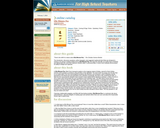
This page contains discussion questions for Death Be Not Proud by John Gunther.
- Subject:
- English Language Arts
- Material Type:
- Activity/Lab
- Provider:
- The Book Report Network
- Date Added:
- 05/04/2017

This page contains discussion questions for Death Be Not Proud by John Gunther.

Students will study poems about death, including A.E. Houseman's "To an Athlete Dying Young" and Dylan Thomas' "Do Not Go Gentle into that Good Night." Students will be able to read, analyze and interpret the poems from both the thematic level of death and the detailed level of poetic form. This lesson also includes a guided analysis of a Shakespearean sonnet.

This literacy assessment includes an excerpt from the book "Winesburg, Ohio," six text-dependent questions, one optional writing prompt, and explanatory information for teachers regarding alignment to the CCSS.

In this lesson on Oedipus the King, students will consider the effects created by Sophocles' unique plot structure.

This lesson plan introduces students to the poetry of Rafael Campo and helps students to find their own voice while gaining confidence writing their own original poetry.

This lesson provides students an opportunity to read a selection about extended family feuds. It details a boundary dispute that has been longstanding for three generations. Students will discover how two families solve this longstanding dispute.

This Random House for High School Teachers reader's guide includes an introduction, discussion questions, and author biography designed to enhance student reading of The Dive from Clausen’s Pier, Ann Packer’s critically acclaimed and bestselling debut novel.

This Random House for High School Teachers reader's guide includes an introduction, questions, and suggestions for further reading designed to enhance student discussion of Peter Heller’s novel about a pilot and his dog trying to survive in a world filled with loss, The Dog Stars.

As a way to support teachers with English Language Arts (ELA) instruction during the pandemic, the NCDPI ELA team created choice boards featuring standards-aligned ELA activities.The intended purpose of these choice boards is to provide a way for students to continue standards-based learning while schools are closed. Each activity can be adapted and modified to be completed with or without the use of digital tools. Many activities can also be repeated with different texts. These standards-based activities are meant to be a low-stress approach to reinforcing and enriching the skills learned during the 2019-2020 school year. The choice boards are to be used flexibly by teachers, parents, and students in order to meet the unique needs of each learner.Exploration activities are provided for a more self-directed or guided approach to independent learning for students. These activities and sites should be used as a way to explore concepts, topics, skills, and social and emotional competencies that interest the learner.

This page contains discussion questions for Ella Minnow Pea: A Novel in Letters by Mark Dunn.

This Random House for High School Teachers reader's guide includes an introduction, discussion questions, and an author biography designed to enhance student discussion of Mark Dunn's book, Ella Minnow Pea, a satirical novel of language and ideas.

This Random House for High School Teachers teacher's guide includes an introduction and overview; discussion questions; author biography; and suggestions for further reading designed to enhance student discussion of Mark Dunn's book, Ella Minnow Pea, a satirical novel of language and ideas.

This page contains a set of discussion questions for Ellen Foster by Kaye Gibbons.

In this lesson on Poe's "The Tell-Tale Heart," students will analyze paragraph 14 and explore how the author develops new ideas in the resolution of the story.

This page contains a summary and detailed analysis of The End of Something by Ernest Hemingway, as well as in-depth discussion questions and prompts for response.

In this TED Ed lesson focused on Homer's "Odyssey," students will explore the cultural background of the work and discuss the significance of its themes. Discussion questions and additional resources available in the sidebar.

All Quiet on the Western Front ends with a startling and ironic conclusion. This ending introduces students to situational irony. After discussing the definition and several examples of situational irony, students explore the novel’s concluding passage. Students next choose a possible alternate ending for the book that could still be an example of situational irony. They then retitle the book and rewrite its ending, maintaining the original ironic tone and weaving their new title into the ending as Remarque does. Finally, students design new, symbolic covers for the book, which feature their new titles.

This resource provides a lesson designed to help students understand the use of satire and the myriad technicques that authors may use to add it to their writing. Students use the film Shrek to examine the four techniques of exaggeration, incongruity, reversal and parody. Students prove their understanding by using satire to rewrite a fairly tale.

Explore the ethnic diversity of U.S. states and neighborhoods. Book: The House on Mango Street by Sandra Cisneros

This Random House for High School Teachers reader's guide includes an introduction, discussion questions, author biography, and suggested reading list designed to enhance student reading of Jonathan Lethem’s acclaimed coming of age novel, The Fortress of Solitude.